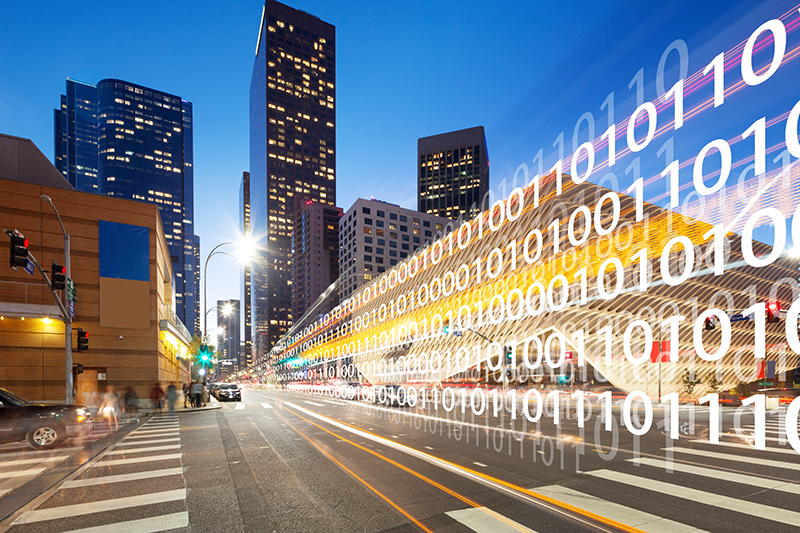How Data Intelligence Prepares Smart Cities for Future Challenges

Preparing for Smart City Growth
Cities will always face challenges, now and in the foreseeable future. Along with sustainability and climate change resiliency concerns, migration growth is high on the list of planning priorities. United Nations experts predict that 68% of the world population will live in urban areas by 2050; cities must be proactive by planning for that growth. Some cities flourish while others flounder, depending on what they offer in terms of quality of life and economic opportunity. Therefore, cities are implicitly competing with each other, and they “win” when provide low crime rates, great transportation systems, and safe walkways and streets to draw residents, visitors and corporations.
To compete effectively, respond to current needs, and plan for the future, urban planners and city officials need accurate data about present patterns and issues. For example, to make cities safer they must consider current pedestrian, bicycle and vehicle traffic patterns, or crime patterns. Likewise, to plan for transportation needs they must gather statistics and data regarding both personal and public transportation, which includes not only trollies, buses or subways, but also vehicles, bicycles and, in some cities, electric scooters.
IoT and Data-Driven Smart Cities
The term “Smart Cities” refers to cities that use Big Data technology as a means of increasing efficiencies, improving residential quality of life, optimizing municipal operations and, of course, securing the environment. Thanks to the Internet of Things (IoT), it is now possible to track all kinds of issues via sensors, cameras and data sets collected in various ways. Boston, Massachusetts is just one example of a city that uses smart technology and Big Data to improve the quality of life for those who work and live in the city and to increase efficiencies in operational management. The City of Boston launched its Analyze Boston website in April this year to track and analyze dozens of metrics, from coastal flood hazard data to traffic crash and fatality records. CityScore, a subsection of the site, tracks a variety of city operational issues, ranging from pothole repairs to EMS calls. The site provides open data not only to City staff and management but to the general public, thus providing a civic tool for multiple stakeholders including urban planners, businesses, residents, visitors and countless others.
Identifying and Leveraging All Digital Data Sources
Today, many cities are using sensors that collect data, but, more often than not, the intelligence is underutilized. For instance, one source of Big Data for cities is their video surveillance infrastructure: Cities and towns can fully leverage the power of existing video surveillance deployments with enhanced video content analytics (VCA) solutions. Intelligent video analytics enables users to unlock previously underutilized video data to drive efficiency and public safety. For example, video content analysis software can accelerate police investigations by enabling rapid video review and search. It also increases citywide situational awareness by providing live real-time alerting for people, vehicles and behaviors.
VCA enables users to gain a full understanding of a scene by analyzing all the objects that appear, identifying and classifying them, and investigating behaviors, such as interactions between objects, dwelling and navigation paths. Ultimately, intelligent video analysis drives the generation of long-term statistical information: Users can create customized dashboards that aggregate and trend identities, object interactions, demographics, hotspots, and vehicle movement patterns over time.
The Value of Video Content Analytics
Video content analytics provides municipalities with an easy, cost-effective way of measuring the efficacy of public infrastructure, transportation services, and the urban landscape. For instance, city planners can monitor vehicular traffic, count cars and pedestrians, and easily note where and when congestion occurs. They can identify where crosswalks, bike lanes, or traffic lights could be placed to streamline traffic. Armed with traffic data, transportation managers could uncover inefficiencies in its streets and highways, design more efficient traffic patterns, plan to expand high-traffic roads, or even increase public transport options. Similarly, mass transit planners can gather accurate data about the usage patterns of a public transportation system to optimize transit schedules.
Why Is Data Intelligence Important for the Future of Cities?
Video content analytics is becoming a key competitive differentiator for cities because it enables city officials and urban planners to make intelligent decisions based on data and insights from video footage. Whether from video analysis or other smart technologies, access to data enables intelligent decision making, empowering the city to offer improved quality of life to current residents and proactively prepare for population growth and city expansion.
City budgets don’t always allow for extensive investment in technology resources, so municipalities looking to transition into a data-driven organization can start by identifying how to maximize existing infrastructure to derive intelligence. For instance, for cities that have already rolled out a network of video surveillance cameras, VCA software is a logical next step in the Smart City transformation, as it leverages a deployed system to provide additional value. Whether with video surveillance and VCA or with other technologies, as the city starts streamlining operations and performance based on data insights, it will free up time and resources to invest back into the city and fostering its growth.
Signup to receive a monthly blog digest.
